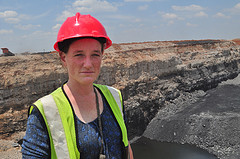
A days journey through South African coal country
Most of my work entails policy wonkery. Though important, especially in Washington, D.C., it often feels distant and far removed from the lives of ordinary people around the world and the lands they call home. Even most of the travel I do for work involves attending international conferences under the harsh shine of florescent lights. Whether in Cancun or Copenhagen, I actually spend far more time in hotel rooms and intergovernmental meetings than with the people who actually live in these places and who are on the receiving end of US foreign policy decisions.
That’s why last month, when I was attending a UN climate conference in South Africa, I jumped at the opportunity to get a reality-check on what US foreign policy actually translates into when implemented on the ground. I went to see first-hand the impacts of a US government-financed coal plant: the Kusile project, one of the world’s largest coal-fired power stations, located in the Mpumulanga Province of South Africa.
 |
| Coal plant ruptures the horizon |
Into the “coal basket” of South Africa
GroundWork/Friends of the Earth South Africa’s amazing director, Bobby Peek, led our journey, along with two local women who very generously lent their time and shared their stories. Our travels included a short airplane ride from Durban to Johannesburg, a car rental, a few occasions of being lost, and Bobby stopping along the side of a rural road so he could get an internet signal in order to deal with urgent fundraising demands. (The man can really multitask — he actually first tried to do this while driving!)
While driving, every which way we looked, we saw testaments to the fact that not only was Mpumulanga Province one of South Africa’s bread baskets, but also its most pre-eminent “coal basket.” In South Africa, coal is king. The country is among the world’s top producers of coal, more than 80 percent of which is produced in Mpumulanga Province. Between May and August of 2010, ambient air pollution exceeded allowed levels 570 times in the Highveld region, where Mpumlanga Province is located.
 |
| Bobby Peek, director of groundWork/Friends of the Earth South Africa, attends to urgent fundraising demands |
The signs of coal’s “bounty” were omnipresent. Huge coal plants ruptured the horizon in multiple directions. Coal mines were plentiful, as were the slower-moving trucks that transport them. (In South Africa, coal predominantly is not moved by rail, but by truck.) This rural farming area has pollution levels that top those of the most polluted industrialized cities.
Waste from coal mining was terribly abundant, and frequently visible in small mounds that were randomly strewn next to the highway. We even stopped along the side of a road to see bottom-of-the-barrel coal that had been dumped right outside houses in impoverished communities.
Unfortunately for those living beings who call Mpumulanga Province home, Eskom, South Africa’s state-owned power company, hopes to build as many as 15 new coal mines there in the next 2 to 4 years.
A visit to a coal mine
 |
| Coal mine in Mpumulanga Province, South Africa |
At one point in the afternoon, Bobby steered the car toward a coal mine and, to everyone’s surprise, skillfully talked his way past the guarded gate and got us an officially-escorted visit hosted by some really nice folks. We drove, and then walked, into the innards of a coal mine amidst sulfur-scented air, donning hard hats and fluorescent yellow vests. To a coal mining novice like me, the mine seemed pretty large, but apparently it is not so big by industrial standards. Like many of South Africa’s open pit coal mines, layer upon layer of earth had been stripped bare to get to the fossilized carbon. I cringed, knowing that this coal is far more likely to be used to power an aluminum smelter owned by some multinational corporation like BHP Billiton, than to provide electricity to South Africa’s poor. (The 38 largest corporations in South Africa use about 40 percent of the electricity from the grid, whereas South Africa’s poor use less than 5 percent.)
An attempt to visit Kusile
Our attempt at visiting the site where the massive Kusile coal plant is being constructed was far less successful but, for different reasons, just as interesting. This 4800 MW behemoth is being financed by the Export-Import Bank of the United States, a federal agency that subsidizes the export of U.S. products and services. In 2011, it chose to finance Kusile, the most greenhouse gas-emitting project ever financed by the agency. Ex-Im Bank provided $805.6 million in financing for the project, and much of that will go to Black & Veatch International of Kansas.
When we arrived near the official entrance to Kusile and started to snap a few photos, a half a dozen or more (I didn’t count…) Eskom security guards and managers surrounded us and made a big fuss. One particularly incensed company employee threatened to snatch the writing pad of a journalist who was with us, ordered us to delete our photos, warned that he would instigate police action (though we were thoroughly amicable and were doing nothing illegal), and literally tailed our car out of town.
 |
| Long line of trucks carrying coal |
Kusile is one of Eskom’s biggest projects. In the company’s press release on the Kusile project, Eskom’s finance director had the audacity to state, “This is … an acknowledgement of the criticality of clean coal in Eskom’s fleet. It will support the building of the capacity we need in order to keep the lights on and improve the quality of life for all South Africans.”
Ha! One might have to fly to Mars in order to be further from the truth.
South African and international civil society groups, as well as medical experts, opposed the Ex-Im Bank loan precisely because it will harm the poor and the planet. It will increase rates of heart, respiratory, cancer, and other ailments, in an area that already exceeds dangerous air pollution levels.
As a press release from groundWork/Friends of the Earth South Africa, Sierra Club, Friends of the Earth U.S., and Pacific Environment states:
On top of the heavy pollution poor communities will bear, the Kusile project will not bring energy access to South Africa’s poor, and does not even include electrification lines for them. What’s worse, Apartheid-era “special pricing agreements” give large industrial users, which consume the lion’s share of South Africa’s electricity, guaranteed rates that are among the lowest in the world. This will force the every-day consumer to bear the weight of these rate increases— on top of the billions of dollars borrowed for the total project cost to build Kusile.
“It becomes a question of who benefits and who pays the price. In this case the poor pay the price and large corporations reap the benefit,” said Sunita Dubey [of groundWork/Friends of the Earth South Africa].
 |
| Bottom-of-the-barrel coal dumped in front of a house |
When we happened to drive by the house of one of the local women accompanying us, the real impact of U.S. government policy on the lives of people in the shadow of Kusile hit me. The building was a tiny structure that looked to be made of brick and mud. It was a home she shared with three other adults and two children, and each time the nearby coal mine blasted, the walls of their home cracked a little bit more.
The women told us that the coal industry had delivered very little in the way of jobs and community projects. Indeed, many people in the communities we passed either couldn’t afford electricity or weren’t even connected to the grid.
And there is absolutely no way that Kusile, a plant that will spew some 36.8 million tons of greenhouse gas emissions annually for up to 50 years, can be called anything but very, very dirty. Ex-Im Bank even had the gall to call the project “carbon capture and sequestration ready” (queue up the well-used response — “just like my driveway is Ferrari ready…”).
US Ex-Im Bank’s fossil fuel binge
If you think that, given our climate-constrained world, Ex-Im Bank’s financing for such a greenhouse-gas-emitting monstrosity is an anomaly, you’d be wrong. The Ex-Im Bank is on nothing less than a fossil fuel binge!
According to perhaps the most knowledgeable person on the topic in the U.S., Doug Norlen of Pacific Environment:
2012 is not looking good either. Ex-Im Bank appears to be interested in financing even more coal in India. This comes on top of its support in 2010 for a massive Indian coal mine and refinery that will emit more than 26 million tons of carbon dioxide per year.
What do Obama’s people say?
U.S. support for Kusile is painfully hypocritical. In April 2010, the US Treasury Department instructed the US representative to the World Bank to rightfully decline to support one of Eskom’s other, equally gigantic (4800 MW) coal plants in South Africa – this one called Medupi. (Unfortunately for South Africa’s poor and the world’s living organisms, the Bank still voted to fund Medupi.) According to a Treasury Department statement on the day of the vote:
Today, the United States abstained on the vote by the World Bank’s Board of Directors on the Eskom Investment Support Project. This reflects concerns about the climate impact of the project and its incompatibility with the World Bank’s commitment to be a leader in climate change mitigation and adaptation.
Yet, just one year later, the U.S. unilaterally financed — via Ex-Im Bank — a coal plant of the same size (i.e. Kusile) in an area of South Africa that’s already significantly more polluted than where Medupi is located. Sigh! Consistency has never been the US’s strong point.
And the hypocrisy continues: the U.S. is now pushing for World Bank funding for a dirty lignite plant in Kosovo.
We have our work in 2012 more than cut out for us.
Related Posts
Ways to Support Our Work

Read Latest News
Stay informed and inspired. Read our latest press releases to see how we’re making a difference for the planet.

See Our Impact
See the real wins your support made possible. Read about the campaign wins we’ve fought for and won together.

Donate Today
Help power change. It takes support from environmental champions like you to build a more healthy and just world.